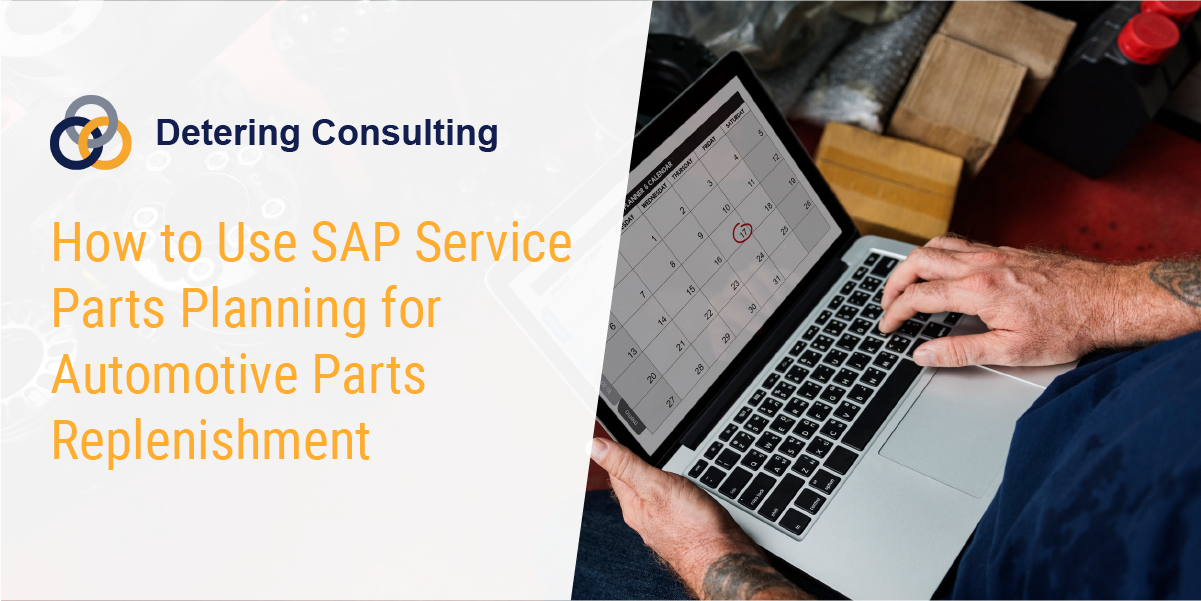Spare Parts Management
Keeping up with changing inventory needs, especially within the automotive industry and other complex manufacturing enterprises, can be taxing. Balancing how much you have in stock with how much you sell requires forethought and prediction skills that sometimes fail you.
How can you keep up with your supply demands? How can you determine when to purchase and when to hold back? How can you reduce inventory costs? How can you improve the end-user experience using SAP Fiori and UI/5 based experience?
SAP has the answers.
Service Parts Management Solution
SAP service parts planning (SPP) provides planning assistance specifically for automotive parts and equipment. The SPP planning process seeks to keep your target level of goods using advanced inventory management practices. The inventory management system determines how many of the service parts you have needed in the past, and uses existing sales orders and forecasts future needs, and assists with spare parts planning and spare parts management to achieve desired inventory levels and meet key KPI objectives.
To accomplish this, it uses the following applications:
- Historical data capture
- Historical data maintenance
- Forecasting
- Inventory planning
You can also transfer this information into other systems, which can then use it for different types of planning.

Auto Replenishment
When the service parts planner determines the number of parts needed to maintain current stocks, the system automatically creates one or more of the following:
- Replenishment proposal
- Purchase requisition
- Purchase order
- Sales order
- Delivery
To establish the requirements for creating these documents, you must set the service part inventory replenishment rule, which uses the following measures:
- Economic Order Quantity: the system reorders a service part when stocks drop below this level
- Economic Order Quantity Period: how often a company orders a service part
- Safety Stock of Each Location: minimal level of stock necessary
- Maximum Stock Levels: the system won’t trigger a reorder at this level because the location has enough service parts
Each of these measures changes over time. For example, you might need 20 parts in December, 12 in April, and 15 in June. This helps maintain a balance between customers’ needs and over-ordering unnecessary parts. This is one of the many reasons spare parts planning within the automotive industry can be so complex. Spare parts management with automotive industry environment is critical to maintaining profitability levels and sustainability.
Planning Service Manager
Keeping track of the many processes used for replenishment takes significant data and planning. SAP uses the planning service manager to complete automated planning tasks such as forecasting, replenishment, and storage planning. The user programs their desired settings into the system, and the planning service manager constantly runs in the background, accessing transaction data, master data, alerts, etc. The system must have the following information to schedule the required services:
- Header Data: specify the planning profile name
- Process Block: define which process files and selections you want in your planning profile
- Service List: specify which version, service, profile, and sequence should be executed
Once you’ve formatted the system to your preferences, you can request the following services under Responsive Replenishment in the planning service manager:
- Forecast order
- Replenishment
- ProAct check
- Transport Load Builder
- Transport Load Builder shipments and replenishment order deletion
When displaying planning services, you can view them as planning files or select specific criteria, such as packaging method, selection, or service.
Forecasting Needed Automotive Parts
The planning service manager has multiple features. The first is forecasting which allows the user to look ahead at what parts you might need in the future. This function can predict the demand for parts, the number of items to purchase, and the average demand for these items.
As mentioned previously, the planning service manager contains the forecasting service. You can also perform forecasting manually using interactive forecasting. The system can determine the best model or processes for forecasting using the automatic selection method. However, if its chosen model doesn’t meet your needs, it can easily be changed in the forecast profile.
To calculate forecast results, you initiate a forecast run. You can also schedule forecast runs using the planning service manager in advance. The system then predicts the number of location products needed, taking into consideration the following:
- Current demand
- Number of order items
- Average demand of order items
Once the system gathers the needed information, it calculates the standard deviation and mean absolute deviation. These statistics are then used in inventory planning. Once the final forecast finishes, service parts planning checks each location product to see which ones need manual approval according to your settings. The system approves all other results and distributes them to other service parts planning services. Historical forecasts save all previous forecasts for use in future predictions.
If you don’t want future forecasts based only on historical forecasts, you can generate leading-indicator-based forecasting. This bases predictions on the current quantity of equipment and automotive parts you have on the market and approximately how often those parts or equipment need to be replenished.
Forecasts can also determine needed quantities of new products just coming to market and outdated products being discontinued.
In addition, the forecasting service analyzes its own performance using the automatic model evaluation. This evaluation uses Trigg’s tracking signal and tripping to decide if the current forecast model works best for you or if you should choose another model.
Product Interchangeability
Using supersession, the service parts manager plans to substitute one product with another. You stipulate the date the discontinuation of the product will begin, and the system plans how to replace the product in an orderly fashion. It then frequently checks the progress of the process to ensure everything is happening on schedule.
If parts are entirely interchangeable, these parts are grouped in a form-fit-function class. The system can then substitute parts in the form-fit-function class for other parts in the same class.
By using supersession and form-fit-function classes, the system can determine product interchangeability and make stocking decisions accordingly.
Inventory Planning
Inventory planning establishes which locations need to increase or decrease their stock based on past demand. This service determines optimal stock levels to maintain stockholding costs, lower purchasing costs, and keep enough materials for customers. In addition, the system checks the potential benefits of stocking or destocking a location, considering a location's safety stock numbers to optimize location product numbers.
The system can determine fast- and slow-moving items by using an ABC classification system that schedules products based on forecasts of outbound activity for the coming year. It uses either normal or Poisson distribution depending on the product’s sales.
Distribution Requirements Planning
Distribution requirements planning manages replenishment using bills of distribution (BOD). A BOD specifies the distribution of automotive parts and other products within your company following delivery from the supplier before the customer purchases them. The individual nodes of a BOD are locations formed into a hierarchy. For example, the top node in distribution might be Phoenix, where the supplier delivers the goods. From there, the BOD branches into tiers. The second tier would be the locations that receive their products from Phoenix. The third-tier nodes receive their products from the second-tier locations and so on. Using BODs, you can carry out distribution planning without a long determination process because the BOD predefines distribution routes using these nodes.
Using this BOD information, the distribution requirements planning system uses forecasted requirements, location stocks, and delivery schedules to generate transport requisitions, schedules agreements, and purchase requisitions. The distribution requirement planning tool takes the following factors into account when making distribution decisions:
- Supplier shutdowns
- Product substitutions
- Obsolete product substitutions
- Discontinuation of products
Generating Demand History
A demand history is the basis for forecasting and planning in the service parts planner.
To create a demand history, you must insert historical data from SAP customer relations management or enterprise resource planning, or both. The system then formats this data to meet the following requirements for service parts planning. The demand history:
- Exists at the location product level
- Exists in various time periods such as monthly or yearly
- Takes into account supersession
- Exists as data in scaled form
- Is data collected along the BOD
Once the data meets these requirements, the system then maintains the historical data. It rearranges the demand history by bearing in mind events, such as:
- Assigning a future BOD to a product
- Creating a supersession
- Changing stocking or destocking decisions
The service parts planner stores the new data as both a demand history and raw data.
Deploying
The deployment section of SAP determines how to distribute products among various locations within a BOD. Any materials not distributed by deployment remain at the receiving node or parent location. The system triggers a deployment when a parent location receives new goods (push deployment) or when a child location needs replenishment (pull deployment).
Inventory Balancing
Inventory balancing is similar to deployment. When a location has too many goods or not enough, inventory balancing redistributes products between the locations in BOD. The planning service manager executes this process.
You can schedule inventory balancing to occur periodically, or the following circumstances will do it for you:
- Supersession of a product over a discontinuing product
- Destocking
- Storage space reduction at a location
- Unfulfilled requisition for replenishment from a child location
- Limited freeze zone increases in demand
Inventory balancing can only take place within a defined area of the BOD. One location can belong to multiple inventory balancing areas. Transferring goods to balance inventory will only take place if the benefits of the balance outweigh the costs of the transfer.
Surplus and Obsolescence Planning
Surplus and obsolescence planning evaluates whether a product is overstocked or obsolete within a BOD and whether it can be disposed of. If the quantity of a product outweighs the demand, it is considered surplus. This includes stocks in transit as well as in the warehouse. An obsolete product meets the following conditions:
- It is part of a product you no longer sell.
- Its mandatory retention period is over.
- Product demand is below a given limit.
You can schedule surplus and obsolescence planning regularly, such as quarterly or semi-annually, in the planning service manager. Or you can begin a review manually if, for example, you need more space. If the system does not tag a product for scrapping, but you believe it should, you can appoint that location product a surplus decision code, which manually tells the system to scrap.
Analytics and Monitoring
The service parts planning analytics and monitoring system consists of the following functions:
Inbound Delivery Monitoring
The inbound delivery monitoring function follows products throughout the delivery process. First, the system determines how much time each process of the product’s journey should take and then times those processes as they happen. Next, it compares the time taken to the standard specified times for that journey. If the delivery process takes too long, a Standard Processing Time Exceeded alert triggers to signal the delay.
Periodically, the system also checks incomplete inbound deliveries for shortages. If a shortage occurs, the system sends a Critical Product (Inbound Delivery Monitor) alert. The system also calculates priority points for inbound delivery items that are still in processing. These priority points indicate the proper unpacking sequence to Extended Warehouse Management.
Inbound delivery monitoring considers stock transfers from one BOD location to another and deliveries from a supplier.
Shortage Analyzing
Shortage analysis alerts both you and your suppliers of critical situations such as shortages of automotive parts and other products. You and the suppliers can use these alerts to prevent urgent problems or respond rapidly to situations that have already become critical.
This function is comprised of the following applications:
- Supplier overview
- Shortage overview
- Shortage monitor
- Service parts planning cockpit
- Analyst’s note
- Alert monitor
- Alert summary
- Product details
Before using the shortage analysis feature, you must begin a planning run in SAP supply chain management within the planning service manager. This gives the shortage analysis function up-to-date information.
Supplier Delivery Performance Rating
Through service parts planning, you can rate your suppliers based on the promptness of their deliveries, advanced notice of shipping, and quantity accuracy, among other criteria. The supplier receives a rating from each delivery location. You can also give suppliers access to view their ratings.
Service Fill Monitoring
You can analyze the proportion of products you sold and delivered on schedule for customer service purposes using service fill monitoring. If service levels are low, service loss analysis delves into why orders were not met on time or could not be met in full.
Looking for SAP Solutions?
Detering Consulting has the SAP solutions you are looking for. We can help you implement the automotive dealer portal to meet your business needs and simplify processes like service parts planning, warranties, stock management, and supplier recovery.
Running your organization doesn't have to feel complicated. SAP will streamline your procedures, and Detering Consulting can walk you through each step to help you see immediate results with low cost and risk.
Contact us today for a consultation.

